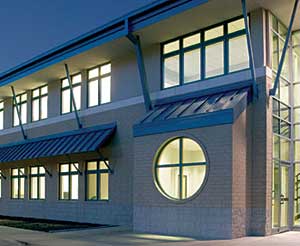AAMA 2605-05 Sets High Standards for Coated Aluminum Extrusions and Panels
Case Studies
Because of its chief attributes-wood interior, ease of maintenance, energy efficiency-extruded aluminum cladding is often preferred over other systems in residential and commercial projects. Rock Island Lofts, in downtown Minneapolis, was originally designed by Oertel Architects, St. Paul, Minnesota, with an all-aluminum window system characteristic of this type of structure. However, developer Shamrock Construction sought windows with a wood interior to achieve a more upscale look, and opted instead for a commercial grade, extruded aluminum that offered a richer interior look and a low-maintenance exterior. On the seventh floor of the building, the window units had to function properly, and meet wind load requirements. The twelve-foot-eight inch by eleven-foot-four-inch window assemblies were installed around a steel substructure from the building interior. The assemblies were designed to be sealed from the exterior and covered with extruded aluminum mull covers.
|
||||||
For the Madison County Highway Department facility in Alton, Illinois, designed by AAIC Inc., Collinsville, Illinois, many energy-efficient windows allow ample natural light into the interior. Extruded aluminum clad windows were finished in Cape Cod Blue in a commercial-grade finish that met AAMA 2605-05 specifications. "We used aluminum clad wood windows because we were looking for energy efficiency and durability in an operable window and a wood look on the interior," says Barry Moyer, AIA, design director at AAIC Inc. "Typically, all-aluminum window systems are used because they're less expensive, but they may not have the energy efficiency or aesthetic appeal of aluminum clad wood frames and sash. We have experienced some surface deterioration, fading, and cracking with vinyl and vinyl clad wood windows specified on projects that are now 10 to 20 years old. I have seen factory-applied paint coatings on aluminum clad wood windows that are 30 years old which exhibit only minimal color change and fading."
Boosting Energy Efficiency
In addition to exterior cladding, the window and door industry offers insulating glass to significantly reduce heat transfer through windows. Two layers of glass protect an inner layer of argon, an inert gas placed between glass panes to improve the insulating value of the sealed glass unit. Many window companies also offer a low-e coating on the glass which can further reduce thermal transmission as well as block out harmful UV rays. In addition to obvious benefits, this coating can also reduce or slow the fading of carpets and furniture. Insulating glass increases energy efficiency while decreasing building heating and cooling costs. In residential construction, insulating glass also reduces the need for storm windows.
Paint and Coatings on Aluminum Extrusions
In understanding extruded aluminum cladding, it is helpful to have a working knowledge of applied coatings and paints. Liquid paint applied to an aluminum substrate consists of 60 percent solvent, 10 percent pigment and 30 percent binder/resin.
Solvents are the liquids that dissolve or disperse other substances; they are the liquid portion of the paint. Pigments are the finely ground, solid particles that provide color and are dispersed in liquid to make paint. When the elements of the environment attack the pigment portion of the paint and cause the color to change, fading occurs.
Binders are the non-volatile resins that bind pigment particles together. Paint binder, or resin, is solid, and represents the bulk of the dry paint. Typically, it is a strong material, and essentially gives the paint its thermal and weathering properties. Because its adhesive quality causes the pigment particles to stick to a substrate, the higher quality the resin, the more durable the paint will be. When high-performance resistance to corrosive environments is called for, resins will be more costly. Polyvinlidene fluoride (PVDF) resin, a thermoplastic fluoropolymer that relies on the superior strength of the carbon-fluoride bond, is one of the strongest chemical bonds in existence. It is used in fluoropolymer resin coatings and paints. PVDF resins should be considered for all projects calling for the highest purity, strength, and resistance to solvents, acids, bases, and heat.











